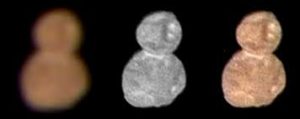Does Ultima Thule resemble snowman?« Back to Questions List
|
Ultima Thule is celestial body that was discovered via telescope in 2014. A detailed image of the icy celestial body was beamed by the NASA’s New Horizon Mission’s spacecraft on January 1, 2018 when it flew past Ultima Thule. The image resembles a giant snowman. According to scientists, Ultima Thule is possibly the farthest and the oldest cosmic body ever observed by a spacecraft. The snowman shape of Ultima Thule makes the scientists believe that the celestial body was formed when two lobes or spheres were gravitated towards each other until stuck together. This turns out to be a great scientific discovery. Prior to this, there was only a blurry image of the body which resembled a bowling pin or a peanut. The lead investigator Alan Stern released the sharper image taken from a distance of just 27,000 kilometers. The picture has a resolution of 140 meters per pixel. The celestial body completes one rotation in approximately 15 hours. Compared to Earth, the sun rays in Ultima Thule is 1,600 times fainter. NASA dubbed the bigger lobe Ultima and the other one Thule. Ultima is about three times bigger compared to Thule. Earlier, it was believed that the celestial body was evolved as a bi-lobe. But NASA scientists are confident of the way of evolution of the body now now, that it formed from two bodies that gravitated towards each other. They state that around 4.5 billion years back a cloud of frozen pebbles began to join forces, gradually forming two bodies; ultima and Thule. Their speed gradually reduced and eventually touched each other at extremely slow speed. Scientists believe that the speed might have been even in the range of just one to a few kilometers per hour. According to scientists, they are really just resting on each other. Saturn- A Unique Planet with RingsMars- The Red Planet |

